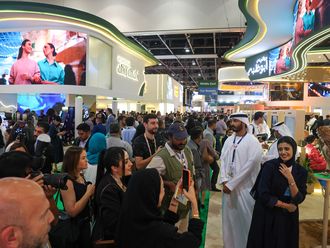John Rishton is contrite. The chief executive of Rolls-Royce admits the flagship British engineering group did not handle its profit warning well.
The first profit warning in February, he means. Not the recent one that sent the group’s shares into a tailspin for the second time in less than eight months.
“The news may not have been what people wanted to hear but it is what is happening in the market,” said. “We are trying to present the news as quickly as we can.”
Rishton, who took the helm from Sir John Rose three years ago, now faces the difficult task of rebuilding investor confidence after disappointments this year. This will not be easy. Although the profit warning was largely focused on the group’s power systems and energy businesses, which have been hit by fears over the global economy and Russian sanctions — it has prompted a rethink about prospects for Rolls-Royce’s most important division.
As the world’s second-biggest jet engine maker, Rolls-Royce derived more than 40 per cent of sales and profit from civil aerospace last year. Despite its global position, Rolls-Royce has struggled to make the margin on its civil aerospace engines that is enjoyed by US rival General Electric.
In June, at the group’s annual investor day, Rishton raised hopes that a combination of cost-cutting and a growing service and maintenance business would at last propel Rolls-Royce into the same league. Instead, this year’s expected 14 per cent civil aerospace margin — against 19.8 per cent for GE’s aviation business in 2013 — is now set to fall back to 12 per cent in 2015.
“They raised expectations so much when they began talking about GE and now they have made clear they cannot do that,” said one analyst who preferred not to be named. Rolls-Royce is now targeting a margin of 14.5 per cent to 15.5 per cent by 2018 for civil aerospace.
But Douglas Harned, an analyst at Bernstein Research, is sceptical. He has set his expectations for Rolls-Royce’s civil aerospace margin as low as 9.1 per cent in 2018, as the maintenance and spare parts business for certain older engines begins to tail off.
Rishton is unapologetic about setting the goal of catching up on his rivals. But he is slightly more circumspect about how he is phrasing that challenge now. “I said we needed to close that gap,” he said. “We are working hard to close that gap and we will see how we get on.”
Rishton insisted he will win over the sceptics. The formula is fairly simple, he argued.
With an order backlog in civil aerospace of ₤58.8 billion (Dh347.66 billion), Rolls-Royce has a good idea of how many engines it will deliver through to 2018. It also knows how long certain engines have been in service and roughly what their rate of maintenance is likely to be.
As lower margin, new engine deliveries level off, and higher margin after-sales services increase, “we will get a shift in the balance,” Rishton said. This should enable Rolls-Royce to increase its civil aerospace margin in the medium term.
In addition, volumes are rising with new engine orders. So Rolls-Royce’s factories — and in particular those in lower cost markets — will be using more of their capacity. “We have a facility in Singapore, which last year made 40 engines, and let’s say it can make 250,” he added.
But investors will need convincing that there will be no more nasty surprises along the way, in particular from Rolls-Royce’s marine and power systems businesses, which make engines and other propulsion systems for ships, rail and defence vehicles, and were built up as a buffer against volatility in the aerospace sector.
“The big change in the commercial engines business of recent years is that it is no longer cyclical,” said Howard Wheeldon of Wheeldon Strategic Advisory. “Even if orders tail off — and they might — they have got a five to six-year order book going forward.”
The concern, analysts said, is whether Rolls-Royce has a clear understanding of the marine and power systems businesses. “They are getting out of their core area and exposing themselves to more perils,” Robert Stallard, an analyst with RBC Capital Markets, said.
But Rishton vehemently rejected suggestions that the marine and power systems businesses should be rationalised or sold off. “We have two businesses with strong fundamentals for growth but in the short term we are subject to the ups and downs of the global economy,” he said. “What we can do in the short term is to concentrate on the things we can control such as driving efficiency and improving the cost base.”
Rolls-Royce became what it is today — a diversified engineering company — under former chief executive Sir John Rose.
In the driving seat from 1996, Sir John masterminded the British jet engine maker’s expansion into new areas largely through acquisitions, buying a trio of companies including Vickers, a key player in the marine market, in 1999.
The logic was that diversification would help Rolls-Royce weather the cyclical nature of its core aerospace and defence businesses, which generate much of its profit.
Sir John looked to further diversify the group with his last big deal — its ₤3 billion purchase of German engineering group Tognum in a joint acquisition with Daimler in 2011. The transaction, which significantly extended Rolls-Royce’s propulsion products on ships, tanks and trains, was sealed under current chief executive John Rishton in June 2011.
Under Rishton, Rolls-Royce has persisted with diversification. In January, it emerged the group had started — and subsequently aborted — talks with Wartsila, the Finnish marine engineer, in a deal that could have been worth almost ₤8 billion and made Rolls-Royce as big in ships as it is in aircraft.
With the Wartsila deal scrapped, Rolls-Royce has chosen to focus on buying Daimler out of its Tognum joint venture, which will enable its full integration into the British group’s power systems business.
But deteriorating economic conditions have hit the power systems business, and Rolls-Royce’s nuclear and energy unit, and this prompted latest profit warning.
There have also been problems at the group’s marine business, and some analysts have therefore questioned the diversification strategy. “These have had limited success as defence has declined long term, energy/power has produced results varying between disappointing and very poor and marine has been very mixed,” said Nick Cunningham, an analyst at Agency Partners.
— Financial Times












